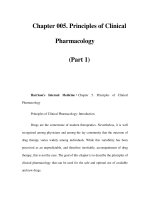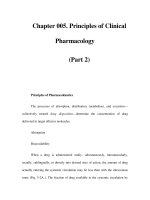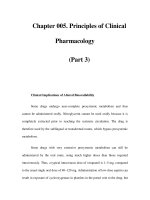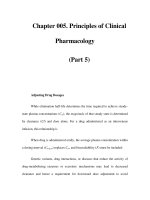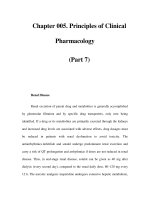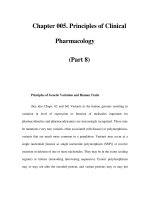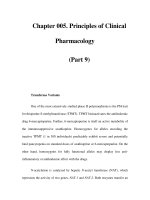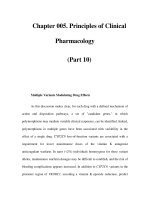Chapter 062. Principles of Human Genetics (Part 30) ppt
Bạn đang xem bản rút gọn của tài liệu. Xem và tải ngay bản đầy đủ của tài liệu tại đây (58.59 KB, 7 trang )
Chapter 062. Principles of
Human Genetics
(Part 30)
DNA testing is performed by mutational analysis or linkage studies in
individuals at risk for a genetic disorder known to be present in a family. Mass
screening programs require tests of high sensitivity and specificity to be cost-
effective. Prerequisites for the success of genetic screening programs include the
following: that the disorder is potentially serious; that it can be influenced at a
presymptomatic stage by changes in behavior, diet, and/or pharmaceutical
manipulations; and that the screening does not result in any harm or
discrimination. Screening in Jewish populations for the autosomal recessive
neurodegenerative storage disease Tay-Sachs has reduced the number of affected
individuals. In contrast, screening for sickle cell trait/disease in African Americans
has led to unanticipated problems of discrimination by health insurers and
employers. Mass screening programs harbor additional potential problems. For
example, screening for the most common genetic alteration in cystic fibrosis, the
∆F508 mutation with a frequency of ~70% in northern Europe, is feasible and
seems to be effective. One has to keep in mind, however, that there is pronounced
allelic heterogeneity and that the disease can be caused by >1400 other mutations.
The search for these less common mutations would substantially increase costs but
not the effectiveness of the screening program as a whole. Occupational screening
programs aim to detect individuals with increased risk for certain professional
activities (e.g., α
1
antitrypsin deficiency and smoke or dust exposure).
Mutational Analyses
DNA sequence analysis is increasingly used as a diagnostic tool and has
significantly enhanced diagnostic accuracy. It is used for determining carrier status
and for prenatal testing in monogenic disorders (Chap. 64). Numerous techniques
are available for the detection of mutations (Table 62-9). In a very broad sense,
one can distinguish between techniques that allow for screening the absence or
presence of known mutations (screening mode) or techniques that definitively
characterize mutations. Analyses of large alterations in the genome are possible
using classic methods such as cytogenetics, fluorescent in situ hybridization
(FISH), and Southern blotting (Chap. 63), as well as more sensitive novel
techniques that search for multiple single exon deletions or duplications.
Table 62-9 Methods Used for the Detection of Mutations
Method Principle
Type of
Mutation Detected
Commonly Used Techniques
Cytogenetic
analysis
Unique visual appearance
of various chromosomes
Numerical or
structural
abnormalities in
chromosomes
Fluorescent in
situ hybridization
(FISH)
Hybridization to
chromosomes with fluorescently
labeled probes
Numerical or
structural
abnormali
ties in
chromosomes
Southern blot
Hybridization with
genomic probe or cDNA probe
after digestion of high molecular
DNA
Large deletion,
insertion,
rearrangement,
expansions of triplet
repeat, amplification
Polymerase
chain reaction (PCR)
Amplification of
DNA
segment
Expansion of
triplet repeats, variable
number of tandem
repeats (VNTR), gene
rearrangements,
translocations; prepare
DNA for other
mutation methods
Reverse
transcriptase PCR (RT-
PCR)
Reverse transcription,
amplification of DNA segment
→absence or reduction of mRNA
transcription
Analyze
expressed mRNA
(cDNA) sequence;
detect loss of
expression
Direct sequencing of PCR
products
DNA sequencing
Sequencing of DNA
Point mutations,
small deletions and
insertions
segments cloned into plasmid
vectors
Restriction
fragment polymorphism
(RFLP)
Detection of altered
restriction pattern of genomic
DNA (Southern blot) or PCR
products
Point mutations,
small deletions and
insertions
Other Techniques
Single-strand
conformational
polymorphism (SSCP)
PCR of DNA segment:
Mutations result in
conformational change and
altered mobility
Point mutations,
small deletions and
insertions
Denaturing
gradient gel
electrophoresis (DGGE)
PCR of DNA segment:
Mu
tations result in
conformational change and
altered mobility
Point mutations,
small deletions and
insertions
RNAse cleavage
Cleavage of mismatch
Point mutations,
between mutated and wild-
type
sequence
small deletions and
insertions
Oligonucleotide
specif
ic hybridization
(OSH)
Hybridization of PCR
products to wild-
type or mutated
oligonucleotides immobilized on
chips or slides
Point mutations,
small deletions and
insertions
Point mutations,
small deletions and
insertions
Microarrays
Hybridization of PCR
products to wild-
type or mutated
oligonucleotides
Genotyping of
SNPs
Protein
truncation test (PTT)
Transcription/translation of
cDNA isolated from tissue
sample
Mutations
leading to premature
truncations
Pyrosequencing
Clonal amplification of
single DN
A fragments on
Sequencing of
whole genomes of
microparticles followed by
massive parallel sequencing
microorganisms,
resequencing of
amplicons
Multiplex
ligation-dependent
probe amplification
(MLPA)
Quantification of PCR-
generated amplicons reflecting
the
number of copies of a specific
DNA sequence
Copy number
variations
